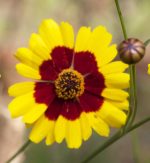
Known by several names including golden coreopsis, plains coreopsis, and calliopsis, this annual is native to much of the US especially the Great Plains and South where it grows in dry fields, roadsides, waste places, and pastures. It is a member of the aster family, Asteraceae, that also includes daisy, yarrow, and lettuce. Growing up to 4′ tall from a fibrous root system, the plant has a 4-sided wiry stem that branches about 2/3 of the way up and carries medium green leaves on short petioles. The leaves are up to 6″ long and may be simple or double-pinnate with linear to lanceolate leaflets or lobes up to 2″ long. From mid summer into fall single flowerheads appear that are 1-2″ across and consist a dark red center of disc florets surrounded by 6-12 ray florets that are are reddish brown at the base and golden yellow at the notched tips. Cultivars are available that offer variety in plant height, and color and number of ray florets. Plants tend to self-seed. Flowering stems are excellent in the vase. Golden tickseed is a very good choice for naturalizing and use in borders, cottage, meadow, wildflower, native plant, herb, and cutting gardens. The genus name, Coreopsis, comes from the Greek words koris meaning bug and opsis meaning like/similar to and refers to the appearance of the seed. The specific epithet, tinctoria, comes from the Latin word tinctorius, meaning used in dyeing, and refers to the use of the flowers to make a mahogany red dye.
Type: Annual
Bloom: Flowerheads with dark red disc florets surrounded by ray florets that are brown at the base and yellow a the tips, from mid summer to fall
Size: 2-4′ H x 12-18″ W
Light: Full sun; tolerates some shade
Soil: Average to lean, dry to medium moist, well-drained
Hardiness: Not hardy
Care: Deadhead to prolong bloom time; may need staking
Pests and Diseases: None of significance
Propagation: Seed
Companion Plants: Cosmos bipinnatus, Cosmos sulphureus ‘Cosmic Orange’, Papaver rhoeas (corn poppy), Orlaya grandiflora (white lace flower)
Outstanding Selections:
‘Mahogany Midget’ (8-12″ tall, deep red ray flowers with yellow center)
‘Mardi Gras’ (8″ tall; deep red ray flowers with yellow tips, yellow center)
Photo Credit: Wikipedia